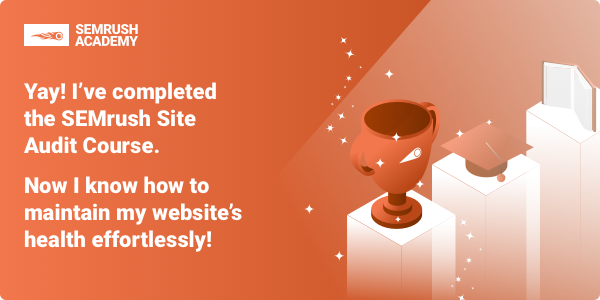TIL: SEMRush Site Audit Tool Certification
Like a lot of people, I have a little more time on my hands these days. And a lot of companies are making their training courses free or very inexpensive, or letting people know about free training already available. As I find courses that I find interesting, I’ll highlight them here in case they might be beneficial to you as well.
If you spend any time in the content marketing world (or if you sift through content-marketing-related job postings), you’ll see three little letters pop up frequently: SEO. As with a lot of things – baking, power tools, gardening – I know just enough about SEO to be dangerously ill-informed (apologies to the SEO guy at my last job who tried really hard to teach me).
Knowing SEMRush to be one of the popular tools when it comes to understanding whether Google likes your website or not, I was pleased to find that they have a number of free courses and certifications. While I have no intention of becoming an SEO expert, I figured it would be helpful to better understand the terminology, especially around an existing site audit. So I decided to start with the course SEMRush Site Audit Course. It was also the first one and it was only an hour long.
Like you would infer from the title, this course focuses a lot on the site audit tool in SEMRush. However, it also gave me a solid understanding of what makes a site attractive to Google. To be honest, if your website were a map and Google was you trying to get across town to a new doughnut shop, you and Google would have similar feelings depending on how the map directed you to go. If the map took you quickly and efficiently across town, you would enjoy your doughnuts and all would be right with the world. If you got to the doughnut shop the long way, or if it took a while for the map to unfold, or if you ran into a dead-end and had to turn around, you’d be rather annoyed with the map, not to mention hungry for doughnuts.
I also learned a little more about terms that I’d heard but didn’t really understand, such as canonical and AMP. I learned a new word – minification, or the process of removing unnecessary lines of code to make a page smaller and easier to load – which is always fun for a word nerd.
There were also some interesting facts related to content marketing, including how Google looks at the relevance of the keywords around internal and external links on a page, and that pages with word counts under 200 can cause it to rank lower. So that’s another reason to add transcripts to videos and captions to image galleries.
Overall, the Site Audit Course was a good first course for someone who knows a little about SEO and who will likely be in meetings where people will be talking about SEO. I’ll definitely be back to check out the other courses on the site.
Proof that I watched all the videos and got the quiz questions correct.
